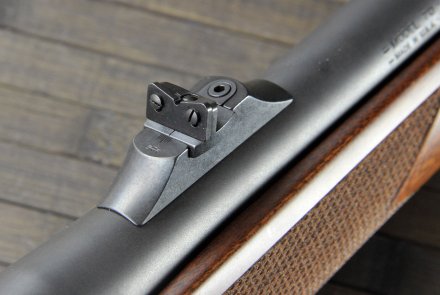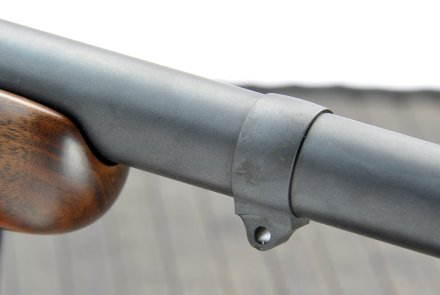Article also available in other languages


The Winchester Model 70 Safari Express is a fixed magazine fed, bolt action rifle designed for dangerous game hunting, and is available chambered in .375 Holland & Holland Magnum, .416 Remington Magnum and .458 Winchester Magnum; considering the Centennial of the .375 H&H Mag. cartridge, and its popularity, we’ve decided to test this chambering of this heavy hunting rifle.

We were skeptical at first, considering the uneven quality of the previous revisions of the Model 70, ranging from mediocre to stellar, and that not even taking into account the Pre-64 production, but also curious. The quality of the rifle we lifted out of the deceivingly poor cardboard box is short of amazing. The Safari Express is, in our opinion, possibly one of the best, non-custom factory made heavy hunting rifles on the market today; and that, well before being further surprised by the affordable price tag.


The stock is built out of extremely solid and heavy American Walnut, featuring a very dense and straight grain, finished flat, that surely is not very fancy, but it’s tough! Two steel cross-bolts, placed ahead of and behind the magazine well, further avoids stock splitting.
On the butt stock a rubber Pachmayr Decelerator Pad checks the healthy recoil of the .375 H&H Mag. The good quality checkering on the fore-end and pistol grip is laser-cut, and it gets the job done. The steel rear sling swivel base, mounted 5 cm from the buttstock, is almost flush with the underside of the stock.

The cold hammer-forged, 4140 chromemoly steel barrel is 24 inches long (610 mm), sports a 1:12 RH rifling and its contour is quite heavy; the barrel starts at 31mm diameter at the receiver and ends at 18.4 mm at the muzzle, which features a recessed crown to protect rifling.
A band front swivel base is mounted on the barrel about 30mm forward of the fore-end tip, since on large caliber rifles, if the sling swivel stud is mounted in the fore-end, it could cause discomfort or injury to the shooter’s hand during recoil.

The barrel features two recoil lugs, the primary is machined into the front of the receiver while the secondary lug is induction-brazed to the barrel approximately 10 cm forward of the receiver; both recoil lugs are glass bedded in “steel epoxy”, which is also used for the bedding of the action screws tunnels and the tang area at the receiver’s rear.


The iron sight package is entirely mounted on the barrel; the front sight is a hooded, ramp mounted brass bead dovetailed into the knurled base, while the rear sight is a fully adjustable, single non-folding leaf, dovetail mounted, Express type V-notch. Once adjusted, the whole rear sight is secured with hefty screws, two slotted for elevation, and one Hex bolt for the windage.


The bolt is the “Pièce de résistance” of the rifle: Model 70 enthusiasts will recognize the super reliable Pre-64 style full length claw extractor, with double, front mounted and opposing locking lugs and the classical three position safety lever on the blued bolt shroud, which is completely machined out of billet stock. The bolt handle base doubles as a third locking lug and sports a round knob, knurled across its diameter.

The bolt assembly release control is found on the left side of the receiver, recessed between the rear part of the wall of the receiver and the tang, right next to the bolt shroud. The spring loaded ejector is receiver mounted, and the breech is coned to improve feeding, already extremely reliable thanks to the controlled round feed (CRF) design.
The receiver is machined out of 4140 chromemoly forged steel and gives an impression of strength and toughness without being overbuilt.
As a matter of fact, the stock is responsible for most of the full 4 kilograms of weight of the Safari Express, a detail immediately appreciable as soon as the receiver is pulled from the receiver.

The fit of the assembly is excellent, to the point of having difficulties putting everything back together.
We found the monolithic steel trigger guard assembly very sturdy and stiff, contributing to the overall rigidity of the rifle; the floorplate is hinged and very well finished. It can be released to unload the rifle by pressing the button placed right in front of the trigger guard; the follower is made of aluminum. The internal magazine holds three double stacked rounds.
Our impression of the M.O.A. trigger mounted on the Safari Express is very positive; we have heard many mixed opinions on this trigger, but we could not find any cons except that the trigger is not user adjustable. The trigger has no take up, absolutely no discernible creep, and breaks like glass with no overtravel; in this, the marketing hype is absolutely spot on, and the pull weight, factory set at just over two kilograms, is correct for a Safari rifle.

Since the receiver is drilled and tapped, mounting a scope is not a problem; it should be noted, though, that the Safari Express has a non-standard, model specific hole spacing for the rear mount.
All exposed metal is finished with a non-reflective, matte blue, except for the portion of the bolt body that resides in the action, which is jeweled.
We tested the rifle at the range, shooting RWS .375 Holland & Holland Magnum hunting ammunition loaded with 300 grain Cone-Point (KS Geschoss) bullets; shooting off the bench we achieved groups averaging a couple of MOAs at a hundred meters, which is excellent considering accuracy can only improve scoping the rifle.


The .375 H&H Mag. is the perfect all-round cartridge, it is the minimum chambering accepted in Africa for dangerous game and has one feature which sets it apart from most other Safari calibers: at typical game ranges, the point of impact stays almost the same using different ammunition brands and bullet weights, which is a definite plus hunting different game with a single rifle.

Operation of the Safari Express is impeccable, even working the bolt at our fastest we’ve never experienced hag-ups or feeding difficulties that were imputable to the action. Recoil is harsh, but not painful; the Decelerator pad and the weight of the rifle dampens the cumulative effects of a full day on the range shooting .375 H&H Mag. loads on the shoulder to a bearable level.
The Safari Express is one tough rifle; it is built like a tank, nonetheless, it is quick enough and comes up to the shoulder and with a natural point of aim surprisingly fast. Sure it’s heavy; but that also means less recoil and faster recovery to shoot accurately that vital second shot, especially when dangerous game can turn back towards the hunter with homicidal intent!

Article also available in other languages















